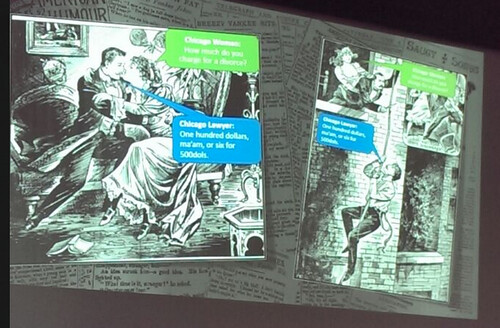Victorian Humour
Victorian humour? A contradiction in terms, surely? Not according to Bob Nicholson, a lecturer in history who is on a mission to make Victorian jokes funny again (which presupposes they were funny in the first place, of course, but one assumes they were!).
Now, you may think this has nothing to do with writing, but it has. Bob is using a computing technique known as “text mining” to trawl through loads of Victorian publications held by the British Library, and extract jokes.
The next stage is to extract what is known as the “meta-data”, and example of which is shown in the illustration below. The<j> and </j> tags indicate that the enclosed text is a joke (as opposed to a news item, say), while the “t” tags refer to the title of the joke as it originally appeared in a publication.
Next, Bob aims to superimpose the jokes onto Victorian illustrations, in the form of speech bubbles. Here’s an example, taken from a photo of one of Bob’s slides. The woman is asking how much the lawyer charges for a divorce, and he replies “$100 or 6 for $500”. You can add to the humour by contextualising the exchange in an illustration.
 A joke superimposed on different illustrations
A joke superimposed on different illustrations
You can view much clearer examples by scrolling own the article entitled Introducing… the Victorian Meme Machine!
So why should any of this be of interest to the writer? I think there are two reasons.
First, the sort of text mining techniques that Bob is using could one day be applied to our work. It’s reassuring, to me at any rate, that even if one is not a big name author one can still achieve a certain kind of immortality, or be of interest to some future historian.
Second, if you have a particular interest in Victoriana, this project certainly will shed some new light on the subject.
If you are so inclined, you can follow Victorian Humour on Twitter and, in due course, receive an automatically generated Victorian joke every day.
In the meantime, listen to Bob explaining what he’s doing:
